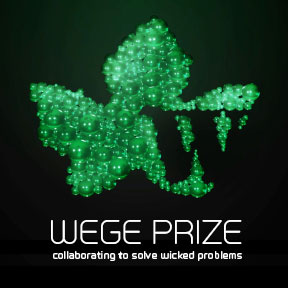
Three AUA Students Compete for 2018 Wege Prize
3 min read YEREVAN, Armenia – The American University of Armenia (AUA) is happy to share that three AUA students, Garo Bozadjian (CIS ‘18), Sinara Gharibyan (MSE ‘18) and Gor Hakobyan (BA ‘18), have been selected to compete for the 2018 Wege Prize, an annual international student design competition that gives teams of different disciplinary and cultural boundaries the opportunity to showcase problem-solving strategies.
YEREVAN, Armenia – The American University of Armenia (AUA) is happy to share that three AUA students, Garo Bozadjian (CIS ‘18), Sinara Gharibyan (MSE ‘18) and Gor Hakobyan (BA ‘18), have been selected to compete for the 2018 Wege Prize, an annual international student design competition that gives teams of different disciplinary and cultural boundaries the opportunity to showcase problem-solving strategies.
The students are teaming up with two other contestants, Natella Gharibyan from Yerevan State Medical University and Vachagan Darbinyan from Armenian National Agrarian University, to form an interdisciplinary team, with each student making contributions based on their own expertise to allow for comprehensive strategizing.
This year’s challenge is to create a circular economy; each team must create and propose a solution to an immense problem. This is to be done in a way that transitions from the current linear economic system of “take, make, and dispose” to a circular economy which aims to keep materials and products at their highest utility and value.
The teams that participate will offer solutions that will prevent or mitigate problems that people face on a global level. The 2018 Wege Prize has 17 teams competing for first, second, and third place, with cash prizes totaling 30,000 USD.
The project’s title, “Carpejur” is a fusing of the Latin word carpe, to seize, and jur, the Armenian word for water. The project is based on an integrated aquaculture system where high water use efficiency is achieved by simultaneous farming of freshwater fish and algae cultivation using fish farm wastewater. The goal is to extract oils from algae for biofuel production, natural fertilizers, and animal feed. As a result, algae growth will treat fish farm wastewater, to produce a clean water state that will be recirculated back into fish production, creating a closed loop operation.
Hakobyan explained that they will first use water for farming fish such as trout, and then transfer the remaining water to another freshwater animal rather than wasting it. Although the water will be slightly contaminated, there are freshwater animals that enjoy this type of water. This cycle of reusing contaminated water will continue until it reaches the last stage, with algae. The algae will filter the water, removing the nitrogen and phosphorus from the water, resulting in sufficient water quality that can be recycled back to the first stage. The water will not be 100% filtered, so about 5% new water will be added to this next cycle. This eliminates harm to the environment and can actually be used in further production by taking the oil from algae and using it as biofuel.
Hakobyan claims that with this plan, “We create new products and energy, we don’t harm the environment, and we use water in an efficient way.”
The project members have all taken serious efforts to research and devise a plan to make their project a reality. In the initial stages, the team had difficulty finding an idea they agreed on, but then one of their advisors, Natella Mirzoyan and Vardan Hayrapetyan from AUA’s Acopian Center for the Environment, proposed the idea of water circulation. Since then, they have taken steps to be more involved and connected with environmental issues.
They have contacted and received data from the Ministry of Nature Protection of the Republic of Armenia; worked with the AUA Acopian Center for the Environment; and created a network with local companies engaged in breeding of freshwater animals.
“I would recommend other students participate in this competition, as this initiative is good for the environment. We have too much waste and don’t know what to do with it. It’s good to get rid of this and help create a clean earth,” said Bozadjian.
“One of the benefits of being involved in this contest is that it’s an international competition, which has more weight, especially since we compete with students coming from prestigious schools, such as Princeton,” remarked Hakobyan.
Gharibyan added, “One of the challenges we face is that, since we don’t know each other very well, we also don’t know each other’s strengths and weaknesses. But that challenge balances itself out because the team members are more or less professionals in their field.”
The team is currently in the second phase of the competition, which ends when they receive the judges’ feedback on February 1. Finalists are announced on March 23 and the final presentation and awards event will take place in Michigan, USA on May 18.
AUA wishes “Carpejur” the best of luck in the Wege competition!
Founded in 1991, the American University of Armenia (AUA) is a private, independent university located in Yerevan, Armenia and affiliated with the University of California. AUA provides a global education in Armenia and the region, offering high-quality, graduate and undergraduate studies, encouraging civic engagement, and promoting public service and democratic values.
